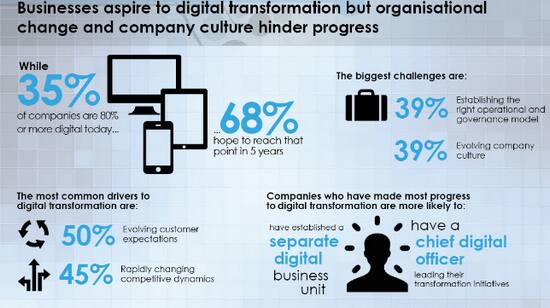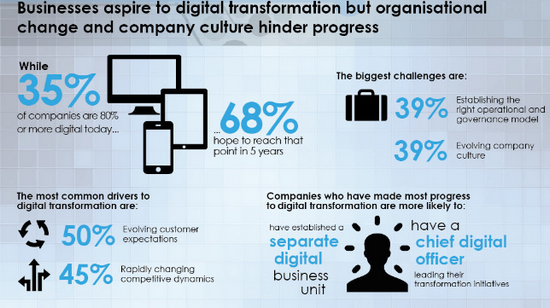While a majority of companies have yet to implement their digital transformation initiatives, most expect their operations to be 80 percent digital or more in the next five years, revealed a new study conducted by The Economist Intelligence Unit. The study, sponsored by Accenture and Pegasystems, is based on a global survey of 444 executives from the healthcare, finance and telecommunications industries. The findings highlighted that two-thirds of companies have digitized roughly half of their operations or less but most plan to be 80 percent digital or more in five years. [caption id=“attachment_2483290” align=“alignleft” width=“550”]
 Source: The Economist Intelligence Unit[/caption] The study suggests that digital transformation aspirations are high, yet making progress can be complex. Only 18 percent of organisations today have fully integrated customer facing processes with their back office systems and only 10 percent report their businesses are fully digital. According to the study, establishing the right operational governance model and evolving company culture are tied as the top challenges to digital transformation, while evolving customer expectations rank as the top driver. Analysis by The EIU revealed two statistically significant groups within the survey sample: those who are ahead of the curve and those who are behind it. Those who are ahead of the curve are more likely to be driven by achieving market leadership and disrupting their core business as motivation for digital transformation. By contrast, behind-the-curve companies are more inward-facing in their focus and are more likely to cite cost pressure and regulatory compliance as drivers leading them to undertake digital initiatives. Four out of ten companies (39%) identify finding the right organisational and governance model for digital transformation as one of their key challenges, making it one of the two most common challenges. The majority of companies have adopted a number of approaches, with the most common among them being a central, strategic initiatives unit that reports to a C-suite executive. However, companies that are ahead of the curve are more likely to have set up separate digital business units. These companies are more likely to outsource digital processes, to invest in digital start-ups and to form a joint venture or partnership to boost their digital capabilities than those that are behind the curve. Perhaps surprisingly, they are less inclined to invest in their internal capabilities. “But the fact that they are more likely to rate the digital transformation capabilities of their company’s functional departments highly suggests that they have started from a stronger position than those that are catching up,” the study said. The report also revealed the organisational practices that have helped some companies get ahead of the digital transformation curve. For example, they are more likely than behind-the-curve companies to have set up a separate unit with responsibility for digital business and have a chief digital officer leading their transformation initiatives. However, these are transitional measures, the report concluded. “The ultimate aim of any digital transformation initiative should be the ability for the whole organisation to transform constantly in response to digital innovation,” said Pete Swabey, senior editor at The Economist Intelligence Unit.
Source: The Economist Intelligence Unit[/caption] The study suggests that digital transformation aspirations are high, yet making progress can be complex. Only 18 percent of organisations today have fully integrated customer facing processes with their back office systems and only 10 percent report their businesses are fully digital. According to the study, establishing the right operational governance model and evolving company culture are tied as the top challenges to digital transformation, while evolving customer expectations rank as the top driver. Analysis by The EIU revealed two statistically significant groups within the survey sample: those who are ahead of the curve and those who are behind it. Those who are ahead of the curve are more likely to be driven by achieving market leadership and disrupting their core business as motivation for digital transformation. By contrast, behind-the-curve companies are more inward-facing in their focus and are more likely to cite cost pressure and regulatory compliance as drivers leading them to undertake digital initiatives. Four out of ten companies (39%) identify finding the right organisational and governance model for digital transformation as one of their key challenges, making it one of the two most common challenges. The majority of companies have adopted a number of approaches, with the most common among them being a central, strategic initiatives unit that reports to a C-suite executive. However, companies that are ahead of the curve are more likely to have set up separate digital business units. These companies are more likely to outsource digital processes, to invest in digital start-ups and to form a joint venture or partnership to boost their digital capabilities than those that are behind the curve. Perhaps surprisingly, they are less inclined to invest in their internal capabilities. “But the fact that they are more likely to rate the digital transformation capabilities of their company’s functional departments highly suggests that they have started from a stronger position than those that are catching up,” the study said. The report also revealed the organisational practices that have helped some companies get ahead of the digital transformation curve. For example, they are more likely than behind-the-curve companies to have set up a separate unit with responsibility for digital business and have a chief digital officer leading their transformation initiatives. However, these are transitional measures, the report concluded. “The ultimate aim of any digital transformation initiative should be the ability for the whole organisation to transform constantly in response to digital innovation,” said Pete Swabey, senior editor at The Economist Intelligence Unit.
Majority of companies plan to be 80% digital in next five years: Survey
FP Staff
• October 26, 2015, 17:45:19 IST
Companies that are ahead of the curve are more likely to have set up separate digital business units.
Advertisement
)
End of Article